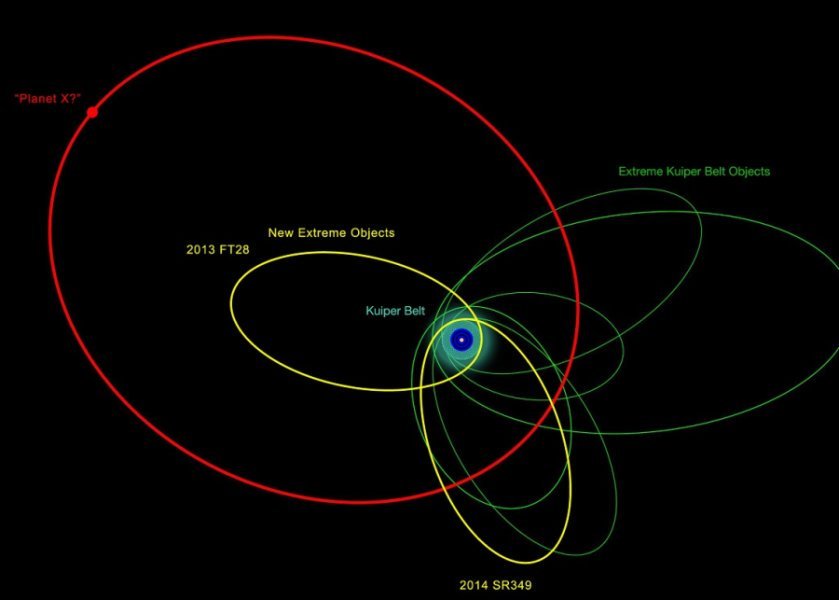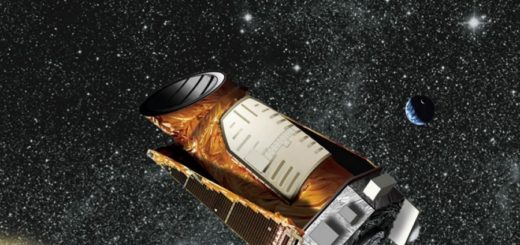Quest For Planet X Continues: Several Never Before Seen Objects Discovered Extremely Far Away From Our Sun

– Something is out there, but what is it? The quest for mythical Planet X or Planet 9, as astronomer call the object continues. Many theories have been put forward, but Planet 9 refuses to give up its secrets and be found. Some astronomers say it doesn’t it. Others have suggested Planet 9 was actually stolen by our Sun about 4.5 billion years ago.
Now astronomers have detected several never before seen objects at extreme distances from the Sun in our Solar System.
The observations were made by Carnegie’s Scott Sheppard and Chadwick Trujillo of Northern Arizona University.
The more objects that are found at extreme distances, the better the chance of constraining the location of the ninth planet that Sheppard and Trujillo first predicted to exist far beyond Pluto.
The placement and orbits of small, so-called extreme trans-Neptunian objects, can help narrow down the size and distance from the Sun of the predicted ninth planet, because that planet’s gravity influences the movements of the smaller objects that are far beyond Neptune. The objects are called trans-Neptunian because their orbits around the Sun are greater than Neptune’s.
In 2014, Sheppard and Trujillo announced the discovery of 2012 VP113 (nicknamed “Biden”), which has the most-distant known orbit in our Solar System. At this time, Sheppard and Trujillo also noticed that the handful of known extreme trans-Neptunian objects all cluster with similar orbital angles. This lead them to predict that there is a planet at more than 200 times our distance from the Sun. Its mass, ranging in possibility from several Earths to a Neptune equivalent, is shepherding these smaller objects into similar types of orbits.
See also:
‘Planet Nine’ May Exist: New Evidence for Another World in Our Solar System
Was Mysterious Planet 9 Stolen By Our Sun 4.5 Billion Years Ago?
Earth’s Periodic Mass Extinctions Linked to Planet X – Researcher Says
Did “Dark Matter” Or A Star Called Nemesis Kill The Dinosaurs?
Some have called this Planet X or Planet 9. Further work since 2014 showed that this massive ninth planet likely exists by further constraining its possible properties. Analysis of “neighboring” small body orbits suggest that it is several times more massive than Earth, possibly as much as 15 times more so, and at the closest point of its extremely stretched, oblong orbit it is at least 200 times farther away from the Sun than Earth. (This is over 5 times more distant than Pluto.)
“Objects found far beyond Neptune hold the key to unlocking our Solar System’s origins and evolution,” Sheppard explained. “Though we believe there are thousands of these small objects, we haven’t found very many of them yet, because they are so far away. The smaller objects can lead us to the much bigger planet we think exists out there. The more we discover, the better we will be able to understand what is going on in the outer Solar System.”
“Right now we are dealing with very low-number statistics, so we don’t really understand what is happening in the outer Solar System,” Sheppard said. “Greater numbers of extreme trans-Neptunian objects must be found to fully determine the structure of our outer Solar System.”
According to Sheppard, “we are now in a similar situation as in the mid-19th century when Alexis Bouvard noticed Uranus’ orbital motion was peculiar, which eventually led to the discovery of Neptune.”
The new objects they have submitted to the Minor Planet Center for designation include 2014 SR349, which adds to the class of the rare extreme trans-Neptunian objects. It exhibits similar orbital characteristics to the previously known extreme bodies whose positions and movements led Sheppard and Trujillo to initially propose the influence of Planet X.
Another new extreme object they found, 2013 FT28, has some characteristics similar to the other extreme objects but also some differences. The orbit of an object is defined by six parameters. The clustering of several of these parameters is the main argument for a ninth planet to exist in the outer solar system. 2013 FT28 shows similar clustering in some of these parameters (its semi-major axis, eccentricity, inclination, and argument of perihelion angle, for angle enthusiasts out there) but one of these parameters, an angle called the longitude of perihelion, is different from that of the other extreme objects, which makes that particular clustering trend less strong.
Another discovery, 2014 FE72, is the first distant Oort Cloud object found with an orbit entirely beyond Neptune. It has an orbit that takes the object so far away from the Sun (some 3000 times farther than Earth) that it is likely being influenced by forces of gravity from beyond our Solar System such as other stars and the galactic tide. It is the first object observed at such a large distance.



 Creators of mankind
Creators of mankind Description of “Tall white aliens”
Description of “Tall white aliens” Where they came from?
Where they came from? About hostile civilizations
About hostile civilizations The war for the Earth
The war for the Earth “Tall white aliens” about eternal life
“Tall white aliens” about eternal life Video: “Nordic aliens”
Video: “Nordic aliens” Aliens
Aliens Alien encounters
Alien encounters The aliens base
The aliens base UFO
UFO Technology UFO
Technology UFO Underground civilization
Underground civilization Ancient alien artifacts
Ancient alien artifacts Military and UFO
Military and UFO Mysteries and hypotheses
Mysteries and hypotheses Scientific facts
Scientific facts


















